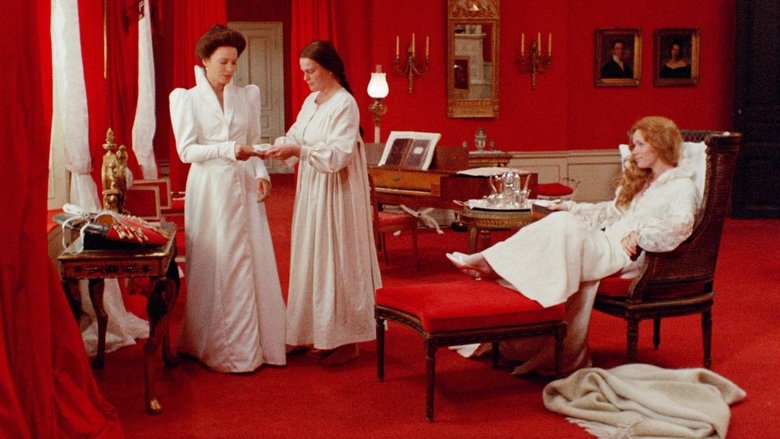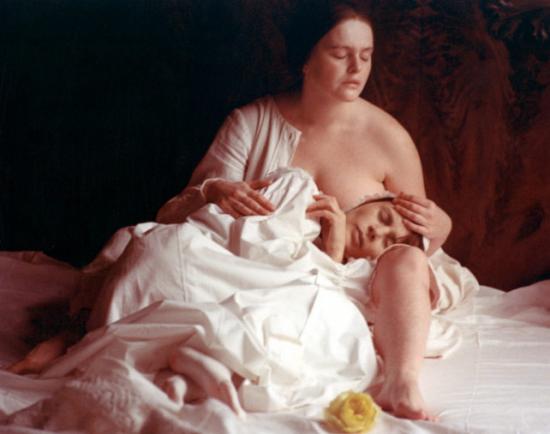← Back to Reviews

in
Cries and Whispers (Ingmar Bergman, 1972) Art House Rating

Bergman's striking study of a dysfunctional family and how it relates to most any and perhaps all families is worthy of the attention of any serious filmwatcher. The thing to remember is that you need to be serious to be able to get the most out of this film because there is very little in the way of lightness to be found. The heaviness of the subject matter could wear some viewers down, but the acting is quite tremendous, as are the set design and costumes which basically fall into a black and white and red all over the walls, curtains, carpets, furniture, clothes, etc. In fact, it's rather appropriate that the manor most of the film takes place at is so full of red since red is the color of blood, and blood represents both life and death. The eldest sister Agnes (Harriet Andersson) is suffering incredible pain as she awaits death, attended to by her married sisters Karin (Ingrid Thulin) and Maria (Liv Ullmann), as well as her loving housekeeper Anna (Kari Sylwan). Eventually, all the sisters recall earlier times in their life when they were both seemingly happier and suffered and/or inflicted pain upon their loved ones, whether imaginary (still emotionally painful) or real.

Eventually, Agnes dies and is put out of her misery, but this just causes all the other main characters to recall or imagine the most intense experiences of their lives, and flashbacks again seem to fill all the characters' hearts and minds. Aside from the memorable color design, Cries and Whispers isn't that different from the intense psychodramas which Bergman was creating on an almost yearly basis. True, this one is probably easier to decipher than most, at least until the third and final act turns into a bona fide horror film and the corpse of Agnes attempts to make peace with her sisters from beyond the grave. This contains the soul of the movie, as well as the way the characters are shown to be able to weave around against each other almost like snakes.

No matter how cold, ruthless and bitterly-honest the film paints the human condition, it's the end of the film which shines an almost hopeful light on how people can attempt to relate to each other. It seems that it's only through the clarity of one's pain that someone can realize how well they have it here on earth, even with your family members who would rather just fight and nag at you over trivialities. You see, under the right conditions, everyone can be at peace and in love with everything and everyone. It's just that most people are too busy "living" to be kind, considerate and downright happy. The simple power of this film is that it takes a voice from the grave, of one who has let go of earthly pain and vanity, to remind those living and left behind how truly beautiful life can be if we only just experience it rather than worry over it. The film's actual ending is one of the most beautiful of any Bergman film, no matter how much suffering it takes to reach it.

Bergman's striking study of a dysfunctional family and how it relates to most any and perhaps all families is worthy of the attention of any serious filmwatcher. The thing to remember is that you need to be serious to be able to get the most out of this film because there is very little in the way of lightness to be found. The heaviness of the subject matter could wear some viewers down, but the acting is quite tremendous, as are the set design and costumes which basically fall into a black and white and red all over the walls, curtains, carpets, furniture, clothes, etc. In fact, it's rather appropriate that the manor most of the film takes place at is so full of red since red is the color of blood, and blood represents both life and death. The eldest sister Agnes (Harriet Andersson) is suffering incredible pain as she awaits death, attended to by her married sisters Karin (Ingrid Thulin) and Maria (Liv Ullmann), as well as her loving housekeeper Anna (Kari Sylwan). Eventually, all the sisters recall earlier times in their life when they were both seemingly happier and suffered and/or inflicted pain upon their loved ones, whether imaginary (still emotionally painful) or real.

Eventually, Agnes dies and is put out of her misery, but this just causes all the other main characters to recall or imagine the most intense experiences of their lives, and flashbacks again seem to fill all the characters' hearts and minds. Aside from the memorable color design, Cries and Whispers isn't that different from the intense psychodramas which Bergman was creating on an almost yearly basis. True, this one is probably easier to decipher than most, at least until the third and final act turns into a bona fide horror film and the corpse of Agnes attempts to make peace with her sisters from beyond the grave. This contains the soul of the movie, as well as the way the characters are shown to be able to weave around against each other almost like snakes.

No matter how cold, ruthless and bitterly-honest the film paints the human condition, it's the end of the film which shines an almost hopeful light on how people can attempt to relate to each other. It seems that it's only through the clarity of one's pain that someone can realize how well they have it here on earth, even with your family members who would rather just fight and nag at you over trivialities. You see, under the right conditions, everyone can be at peace and in love with everything and everyone. It's just that most people are too busy "living" to be kind, considerate and downright happy. The simple power of this film is that it takes a voice from the grave, of one who has let go of earthly pain and vanity, to remind those living and left behind how truly beautiful life can be if we only just experience it rather than worry over it. The film's actual ending is one of the most beautiful of any Bergman film, no matter how much suffering it takes to reach it.
